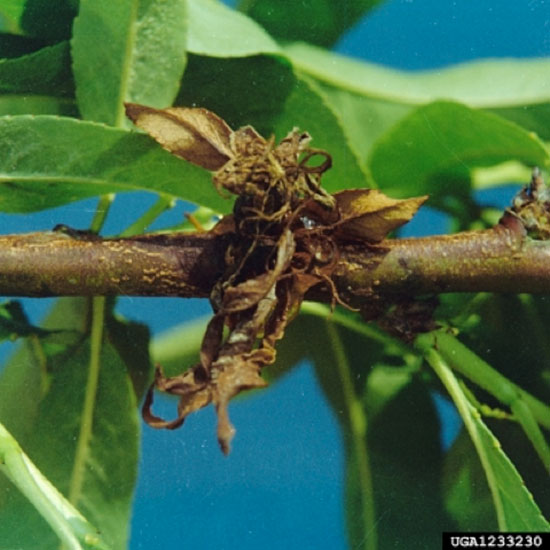Issue 2, April 30, 2012
Brown rot vs. Fire Blight
Brown Rot can cause blossom blight, stem canker, and dieback of peach, cherry and other stone fruit species. The visual symptoms of brown rot have many similarities to symptoms caused by fire blight on apple, pear and many other species in the rose family. The pathogens that cause brown rot and fire blight are very different. Fire blight is a bacterial disease caused by the pathogen Erwinia amylovora. Brown rot is a fungal disease caused by the pathogen Monilinia fructicola. Proper identification of the disease is critical when considering control options, especially when selecting pesticides.
Brown Rot is a common and destructive disease of stone fruits (peach, plum, cherry, etc.). Fruit growers face significant yield losses as a result of infected fruits rotting in the orchard, in storage and transit, as well as at the market. In the landscape, ornamental species are commonly damaged by blossom blight and twig cankers. Fire blight can also cause significant yield losses in orchards. Similarly to brown rot, fire blight can cause blossom blight, shoot blight, as well as branch cankers.
Blossoms infected with brown rot have rapidly enlarging brown spots on the flower petals, stamens, and pistils. Infected flowers soon wilt and turn brown. Withered flowers may persist on the tree into the summer and may be covered with brownish-gray fungal spores. Blossom blight caused by the fire blight pathogen will not have the brownish-gray fungal spores present. Fire blight will cause blossoms to appear water soaked, shriveled, and brown-black in color.
Both infections continue to progress into fruit spurs, small stems, and branches. Brown rot infections on twigs and smaller branches appear as oval or elliptical cankers. They are usually brown, sunken, and form a definite outline. Gum commonly oozes out at the edge of the cankered surface during wet periods, especially on apricots. This gumming may be confused with bacterial oozing associated with fire blight. Cankers associated with brown rot which may have scattered, tan-gray spore tufts also appear on the bark surface under wet and humid conditions. Twig blight results when a canker completely encircles a twig or branch. Blighted twig leaves often wilt, turn dull green, then a light brown, wither, and die but remain attached to the blighted twigs.

Brown rot on peach-Clemson University - USDA Cooperative Extension Slide Series, Bugwood.org
Fire blight cankers appear somewhat sunken and a darker color, relative to the surrounding healthy tissue. The margins of expanding cankers may appear slightly raised. Cankers may exude a milky-white or amber colored ooze, especially from bark lenticels. Leaves on blighted stems die and turn either dark brown or black and remain attached throughout the growing season. Frequently, the tip of the blighted shoot bends over and resembles a shepherd's crook, a distinctive identification feature for this disease.

Fire blight on Callery Pear -U of I Plant Clinic
More Information on the identification and control of brown rot as well as fire blight can found within the following Reports on Plant Disease:
RPD #801 Fire Blight of Apple (Adobe PDF)
RPD #804 Brown Rot of Stone Fruits (Adobe PDF)
(Travis Cleveland)
Author:
Travis Cleveland